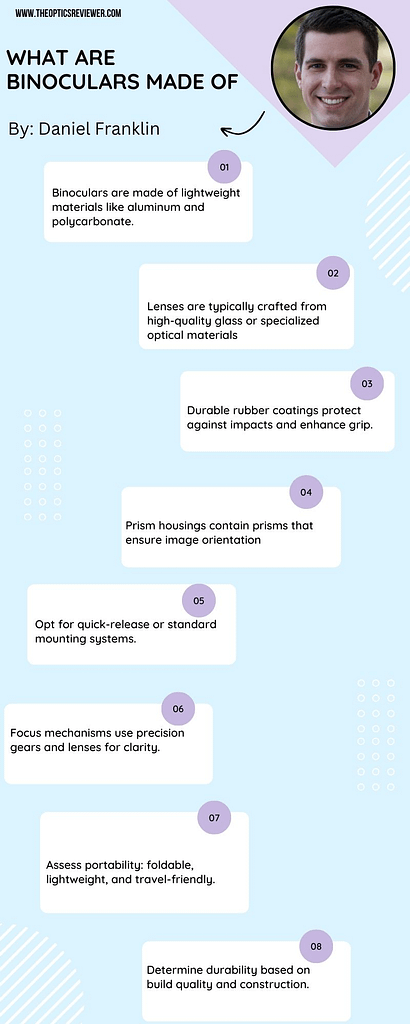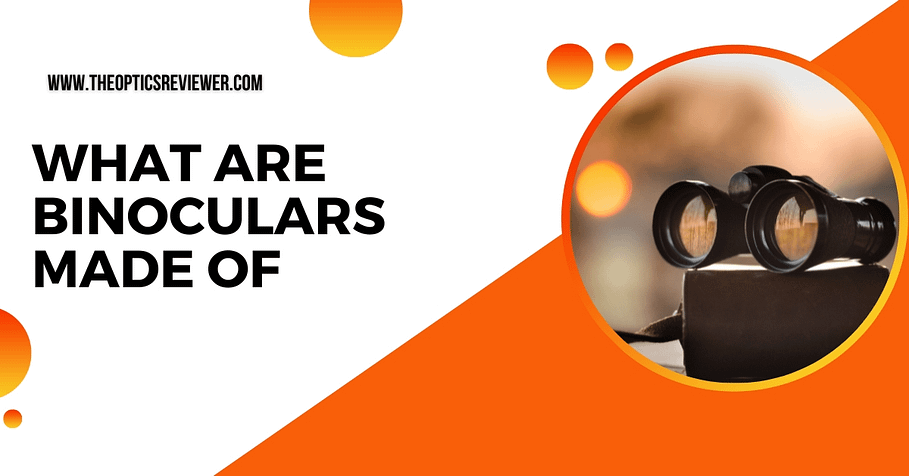Binoculars have become an indispensable tool for many outdoor enthusiasts, nature lovers, and even professionals in various fields. They allow us to observe distant objects with clarity and detail, bringing the world closer to us. But have you ever wondered What Are Binoculars Made of? The answer is not as simple as it may seem.
The materials used in the construction of binoculars play a crucial role in their performance and durability. In this discussion, we will explore the fascinating world of binoculars and delve into the various components that make up these remarkable devices. Brace yourself for a journey through the intricate craftsmanship and innovative materials that come together to create the binoculars we rely on for our adventures.
Contents
- 1 Key Takeaways
- 2 What are Binoculars Made of?
- 3 What are the Different Parts of Binoculars?
- 4 What is the Function of the Objective Lenses in Binoculars?
- 5 How Do You Choose the Right Binoculars for Your Needs?
- 6 How Does the Weight of Binoculars Affect Their Performance?
- 7 What are Some Ways to Reduce the Weight of Binoculars?
- 8 What are Some Tips for Carrying Binoculars for Long Periods of Time?
- 9 Conclusion
- 10 Frequently Asked Questions
Key Takeaways
- Binoculars are made up of various parts, including objective lenses, eyepieces, prisms, and barrels.
- The choice of materials used in binocular construction, such as optical glass, metal alloys, and plastics, is crucial for optimal performance and durability.
- Lightweight materials like magnesium, carbon fiber, fluorite, and ED glass are utilized to reduce the overall weight of binoculars while maintaining image quality.
- Design and comfort features, such as compact bodies, adjustable straps, ergonomic designs, and proper weight distribution, are essential for enhancing portability, comfort, and usability of binoculars.
What are Binoculars Made of?
Binoculars are constructed using a combination of high-quality materials, carefully selected and engineered to ensure optimal performance and durability. The manufacturing techniques employed in the production of binoculars have evolved over time, resulting in significant advancements in design and functionality.
The main materials used in binocular construction include optical glass, metal alloys, and various types of plastic. The lenses and prisms are typically made of high-quality optical glass, which is chosen for its ability to transmit light and minimize distortion. Metal alloys, such as aluminum or magnesium, are used for the framework and internal components of the binoculars, providing strength and stability. Plastic is utilized for the exterior casing and other non-essential parts, as it is lightweight and cost-effective.
The environmental impact of binocular production is a growing concern in today’s society. Manufacturers are constantly striving to reduce waste and minimize the use of harmful chemicals in their production processes. Additionally, efforts are being made to improve the recyclability of binoculars and promote sustainable manufacturing practices.
In terms of innovations in binocular design, manufacturers are incorporating features such as waterproof and fog-proof capabilities, image stabilization technology, and enhanced lens coatings to improve visibility in challenging conditions. These advancements have greatly enhanced the usability and versatility of binoculars.
The history of binocular manufacturing dates back to the early 17th century, with the development of the first telescopic devices. Over the years, the design and construction of binoculars have evolved, with significant contributions from notable figures such as Galileo Galilei and Carl Zeiss. Today, binoculars are a staple tool for various industries, including astronomy, birdwatching, and hunting, thanks to the continuous advancements in their manufacturing techniques and materials used.

What are the Different Parts of Binoculars?
The different parts of binoculars, essential for their functionality and optical performance, include objective lenses, eyepieces, prisms, barrels, a diopter knob, and a focusing wheel. Each of these components plays a crucial role in the overall design and functionality of binoculars.
Objective lenses are located at the front of the binoculars and are responsible for gathering light and forming an image of the object. The size and quality of these lenses greatly impact the brightness and clarity of the image.
Eyepieces, located at the back of the binoculars, magnify the image formed by the objective lenses. The quality and design of the eyepieces contribute to the overall viewing experience.
Prisms are used to reflect and refract light, allowing for the formation of an image. They also correct the image orientation, flipping it vertically and horizontally. The type of prism employed in the binoculars greatly affects the quality of the image.
Barrels hold the objective lenses and eyepieces in place. They are usually made of metal or plastic and contribute to the durability and stability of the binoculars.
A diopter knob allows for customization of the binoculars based on individual eyesight variations. It enables users to adjust the focus of each eyepiece independently to compensate for differences in vision.
Lastly, the focusing wheel allows users to adjust the focus of the binoculars for objects at different distances. This feature is crucial for achieving clear and sharp images.
If interested lets read more about who invented the binoculars.

What is the Function of the Objective Lenses in Binoculars?
The objective lenses in binoculars serve the crucial function of gathering light and forming a clear and magnified image of the observed object. To better understand the importance of objective lenses in binoculars, consider the following points:
Importance of lens coatings in binoculars:
- Anti-reflective coatings on the objective lenses reduce glare and improve light transmission, resulting in brighter and clearer images.
- Coatings also enhance color fidelity and contrast, allowing for a more realistic and detailed viewing experience.
Common materials used for binocular prisms:
- Porro prisms, typically made of glass, are commonly used in binoculars. They offer good optical performance and are more affordable.
- Roof prisms, made from a higher quality glass, provide a more compact design and better light transmission, resulting in a brighter image.
Exploring the benefits of larger objective lenses in binoculars:
- Larger objective lenses allow more light to enter, resulting in brighter images, especially in low-light conditions.
- They also provide a wider field of view, allowing for better observation of a larger area.
How Do You Choose the Right Binoculars for Your Needs?
After understanding the importance of objective lenses in binoculars, the next step is to determine how to choose the right binoculars for your specific needs. Choosing binoculars involves considering several factors such as determining the magnification power, considering the field of view, evaluating lens quality, and finding the right size.
To begin, determining the magnification power is crucial as it determines how much closer the objects will appear. Binoculars with higher magnification power will provide more detailed views but may also result in a narrower field of view and a shakier image. It is important to strike a balance between magnification power and stability.
Next, the field of view should be taken into account. This refers to the width of the area you can see through the binoculars. A wider field of view allows for easier tracking of moving objects and provides a more immersive experience.
If interested you can read more about where are bushnell binoculars made.
Evaluating lens quality is essential as it directly affects the clarity, brightness, and color reproduction of the image. Look for binoculars with high-quality lenses that minimize distortion and provide sharp images.
Lastly, finding the right size is important for comfort and portability. Consider factors such as weight, compactness, and ease of handling to ensure a comfortable and convenient experience.
How Does the Weight of Binoculars Affect Their Performance?
The performance of binoculars is significantly affected by their weight, influencing factors such as stability, ease of use, and portability. The weight distribution of binoculars plays a crucial role in their overall performance. Here are some key points to consider regarding the impact of weight on binocular performance:
- Weight distribution: The distribution of weight affects the balance of the binoculars, which in turn affects stability. Binoculars with a well-balanced weight distribution are easier to hold steady and provide a clearer view.
- Impact on stability: Heavier binoculars are generally more stable, as they are less prone to hand movements. This stability is particularly important when observing distant objects or during prolonged use.
- Ergonomics and comfort: The weight of binoculars can influence their ergonomics and comfort. Lighter binoculars are often more comfortable to hold for extended periods, reducing strain on the hands and neck.
- Influence on hand fatigue: Heavy binoculars can cause fatigue in the hands and arms, affecting the user’s ability to hold them steady. Lighter binoculars are less likely to cause hand fatigue, allowing for longer and more enjoyable observation sessions.
- Impact on long-term use: The weight of binoculars also has an impact on long-term use. Lighter binoculars are easier to carry and transport, making them more suitable for activities such as hiking or birdwatching.
Considering these factors, it is important to choose binoculars that strike the right balance between weight and performance, ensuring a comfortable and stable viewing experience.
If interested you can read more about are 80 x 80 binoculars good.
What are Some Ways to Reduce the Weight of Binoculars?
To reduce the weight of binoculars, manufacturers can employ various techniques and utilize lightweight materials in their construction. Here are some ways to achieve this:
Lightweight materials:
- Manufacturers can use lightweight materials, such as magnesium or carbon fiber, for the construction of the binoculars. These materials have high strength-to-weight ratios, making them ideal for reducing the overall weight of the device.
- Optics can be made from lightweight materials, like fluorite or ED (Extra-low Dispersion) glass, which maintain excellent image quality while minimizing weight.
Compact design:
- Designing binoculars with a compact body allows for a smaller and lighter form factor. By reducing the overall size of the binoculars, manufacturers can significantly reduce their weight.
Adjustable straps:
- Incorporating adjustable straps into the design allows users to customize the fit and distribute the weight evenly across their body. This prevents excessive strain on the neck and shoulders, promoting comfort during extended use.
Ergonomic body:
- Manufacturers can focus on designing binoculars with ergonomic bodies that fit comfortably in the hand. This not only enhances the user experience but also reduces the perception of weight.
Weight distribution:
- By carefully considering the weight distribution of the binoculars, manufacturers can ensure that the device feels balanced and comfortable to hold. This can be achieved through strategic placement of heavier components and counterweights.
What are Some Tips for Carrying Binoculars for Long Periods of Time?
When carrying binoculars for long periods of time, there are several tips that can improve comfort and stability. One of the most common techniques is to use a neck strap or harness to distribute the weight of the binoculars and make them more comfortable to carry for extended periods. Adjusting the position of the binoculars can also help reduce strain and improve stability. By bringing your thumbs and wrists closer together on the binoculars and focusing from the underside using your thumbs, you can achieve a more secure grip and minimize shaking. Another option to consider is a binocular harness, which can secure the optics and distribute their weight on both your shoulders, making them more comfortable for long-term use.
In addition to these carrying techniques, using a wide, non-stretchy strap can help distribute the weight of the binoculars and make them easier to hold steady. This can be especially helpful for heavier models. Adding a forehead rest can also improve stability, especially for heavier binoculars. By resting your forehead against a cushioned support, you can reduce shakiness and maintain a steady view. These tips for comfort and weight distribution can greatly enhance the experience of carrying binoculars for long periods of time.
If interested you can read more about when were binoculars invented.
Conclusion
In conclusion of What Are Binoculars Made of, we discussed that binoculars are essential optical instruments used for magnifying distant objects. They consist of various parts, including objective lenses, eyepieces, and a prism system. The objective lenses are responsible for gathering and focusing light, while the prism system ensures correct orientation of the image.
Binoculars are typically made of lightweight materials such as aluminum or plastic to reduce their weight and enhance portability. To ensure optimal performance, it is crucial to choose binoculars that align with your specific needs and preferences. So, keep your eyes peeled and explore the world with the aid of these remarkable devices.
Frequently Asked Questions
Are Binoculars Waterproof?
Waterproof binoculars are designed with advanced waterproofing technology and feature waterproof seals to protect against water damage. They are also fog proof, ensuring clear visibility even in wet conditions. The waterproof rating indicates their level of water resistance.
Can Binoculars Be Used at Night?
Binoculars equipped with night vision capabilities and optimized for low light performance are ideal for nighttime wildlife observation and astronomy. Their ability to amplify light and enhance visibility makes them indispensable tools for stargazing enthusiasts.
How Do I Clean the Lenses of My Binoculars?
To clean the lenses of your binoculars, use gentle, circular motions with a microfiber cloth or lens cleaning brush. Avoid using harsh chemicals and always remove dust particles before wiping to prevent scratches.
Can Binoculars Be Used for Stargazing?
When comparing telescopes and binoculars for stargazing, each has its advantages. Binoculars offer a wider field of view, portability, and ease of use. Tips for stargazing with binoculars include learning the night sky, using a tripod, and adjusting the focus. Choosing the right binoculars for stargazing involves considering factors such as the magnification and objective lens size. Common mistakes to avoid when using binoculars for stargazing include not stabilizing the binoculars, not adjusting the inter-pupillary distance, and using binoculars with low-quality optics.
Are There Binoculars Specifically Designed for Bird Watching?
When it comes to bird watching, the best magnification for binoculars is typically between 7x and 10x. Look for features such as a wide field of view, close focus capability, and image stabilization. Some top brands for bird watching binoculars include Nikon, Zeiss, and Swarovski. To choose the right binoculars for bird watching, consider factors such as weight, size, and durability. When using binoculars for bird watching, keep in mind to adjust the focus, stabilize your hands, and use them in good lighting conditions for optimal viewing.

